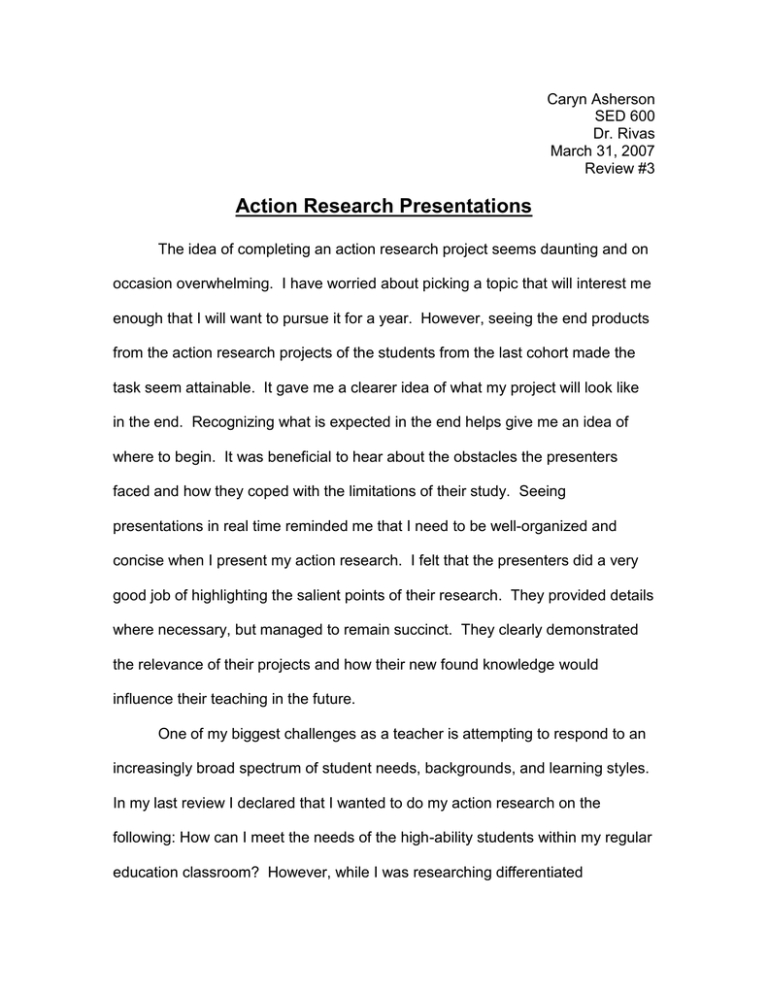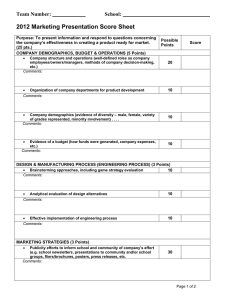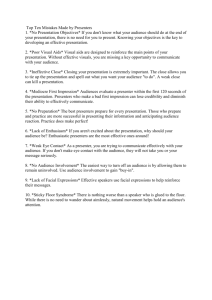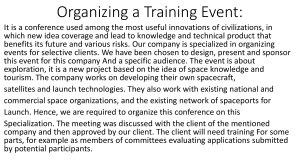Review #2 - Action Research
advertisement

Caryn Asherson SED 600 Dr. Rivas March 31, 2007 Review #3 Action Research Presentations The idea of completing an action research project seems daunting and on occasion overwhelming. I have worried about picking a topic that will interest me enough that I will want to pursue it for a year. However, seeing the end products from the action research projects of the students from the last cohort made the task seem attainable. It gave me a clearer idea of what my project will look like in the end. Recognizing what is expected in the end helps give me an idea of where to begin. It was beneficial to hear about the obstacles the presenters faced and how they coped with the limitations of their study. Seeing presentations in real time reminded me that I need to be well-organized and concise when I present my action research. I felt that the presenters did a very good job of highlighting the salient points of their research. They provided details where necessary, but managed to remain succinct. They clearly demonstrated the relevance of their projects and how their new found knowledge would influence their teaching in the future. One of my biggest challenges as a teacher is attempting to respond to an increasingly broad spectrum of student needs, backgrounds, and learning styles. In my last review I declared that I wanted to do my action research on the following: How can I meet the needs of the high-ability students within my regular education classroom? However, while I was researching differentiated instruction for my panel presentation, I started to ask myself why I should be only focusing on the advanced students in my classroom? Aren’t the low achieving students just as important? How can I make my classroom a good fit for students who either struggle to learn or learn with ease? A piece of advice that all three presenters offered was to keep the action research project simple. I thought that by concentrating on one group of students in my classroom, I would be simplifying my study. Yet, I realize now that it plausible for me to focus on all of the differing student ability levels in my classroom. In addition to researching more about differentiation, I am considering including Howard Gardner’s theory of multiple intelligences, as well as Benjamin Bloom’s taxonomy of educational objectives in my literature review. Furthermore, differentiated instruction promotes the use of continuous assessment to identify students’ readiness levels. Because of this, I want to work on creating authentic assessments that will enable me to respond instructionally to the differences among my students. At the moment, my main form of assessment remains tests and quizzes. I feel pressured to give tests and quizzes in order to have concrete and quantifiable grades to show parents. Nevertheless, these grades only show me what my students have learned at the end of a unit. Moreover, performance on tests does not necessarily give me accurate information on student understanding. ELL students may be answering questions incorrectly because of the language barrier rather than because they do not know the information. I want to know what students understand during the unit so that I can see where I need to differentiate and adjust my instructional plans. My ultimate goal is to provide a learning environment that is safe and challenging for each student. I want to focus on diagnosing my students’ learning needs accurately and practically. Eventually, I want to become an expert at providing learning opportunities that will increase the likelihood of success for all my students.


